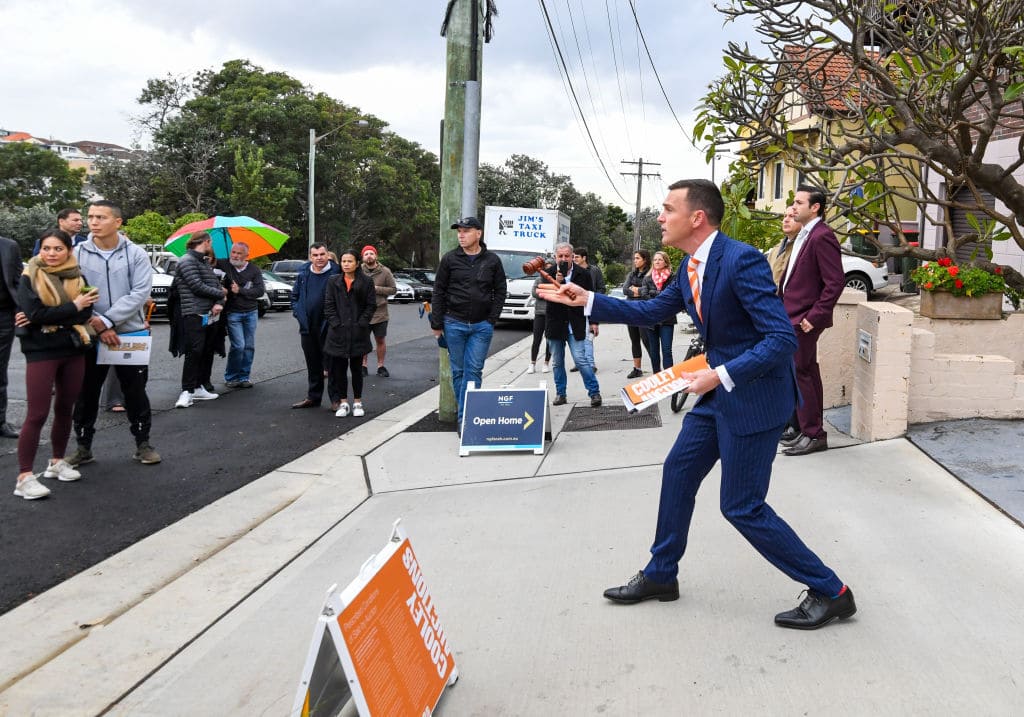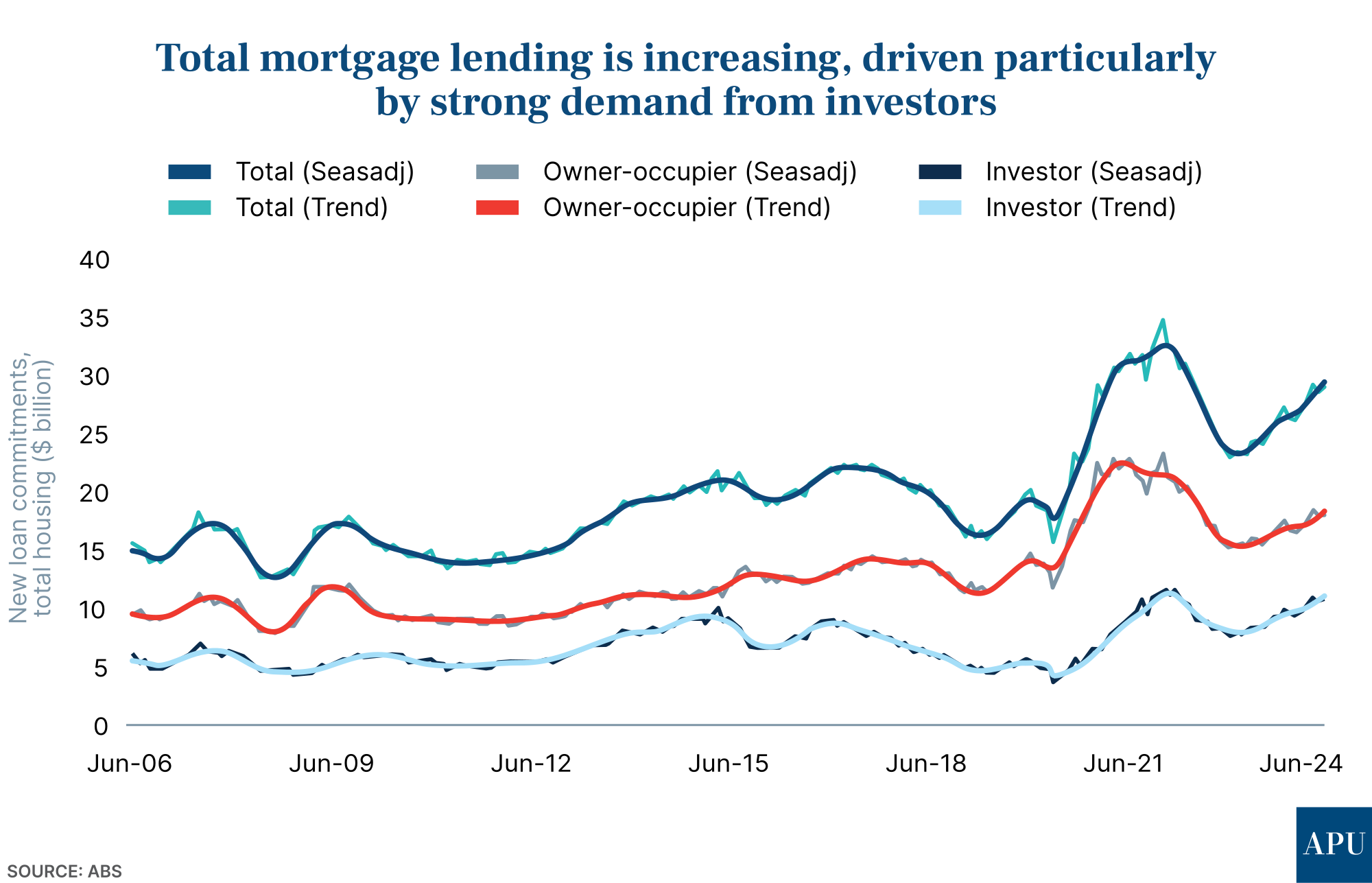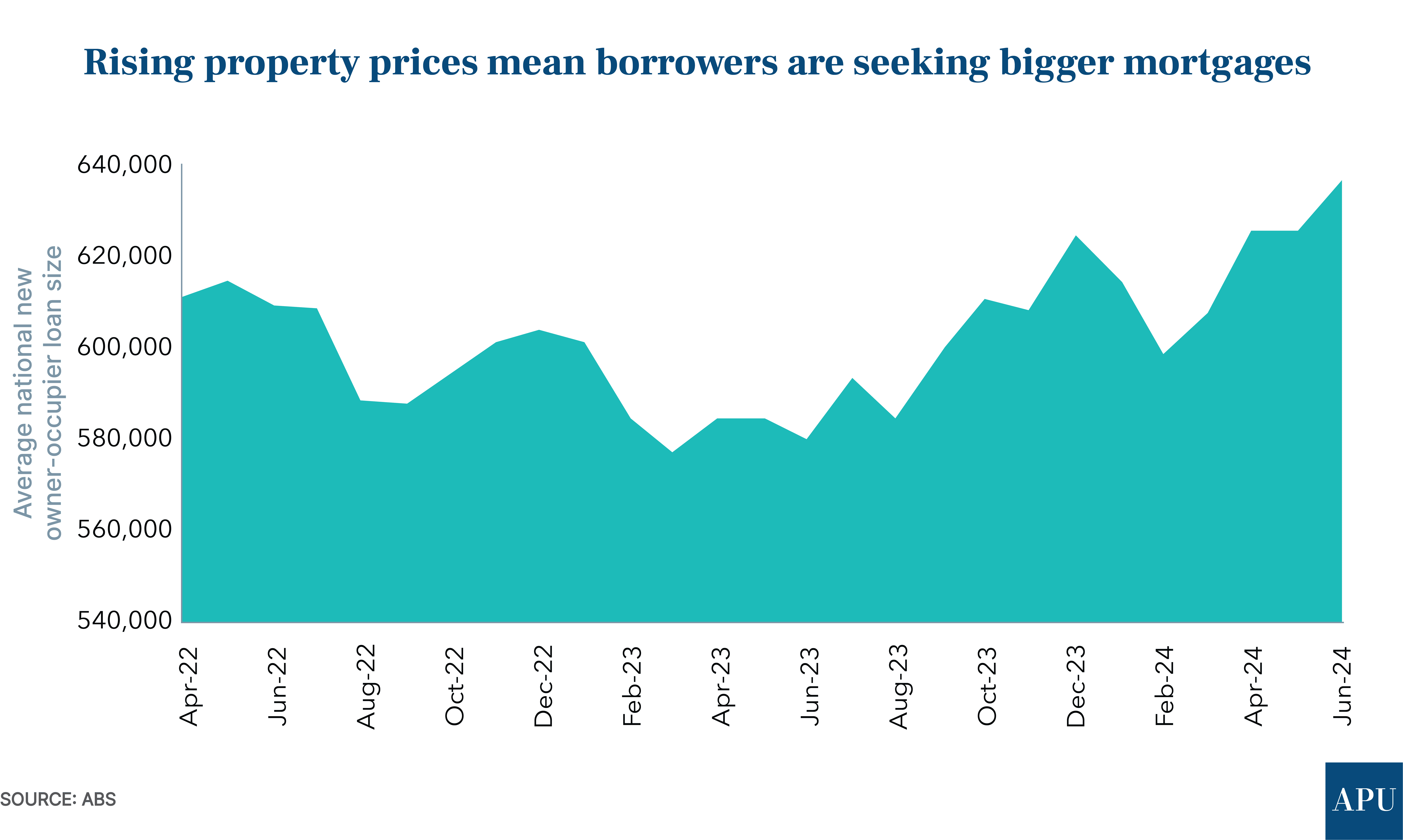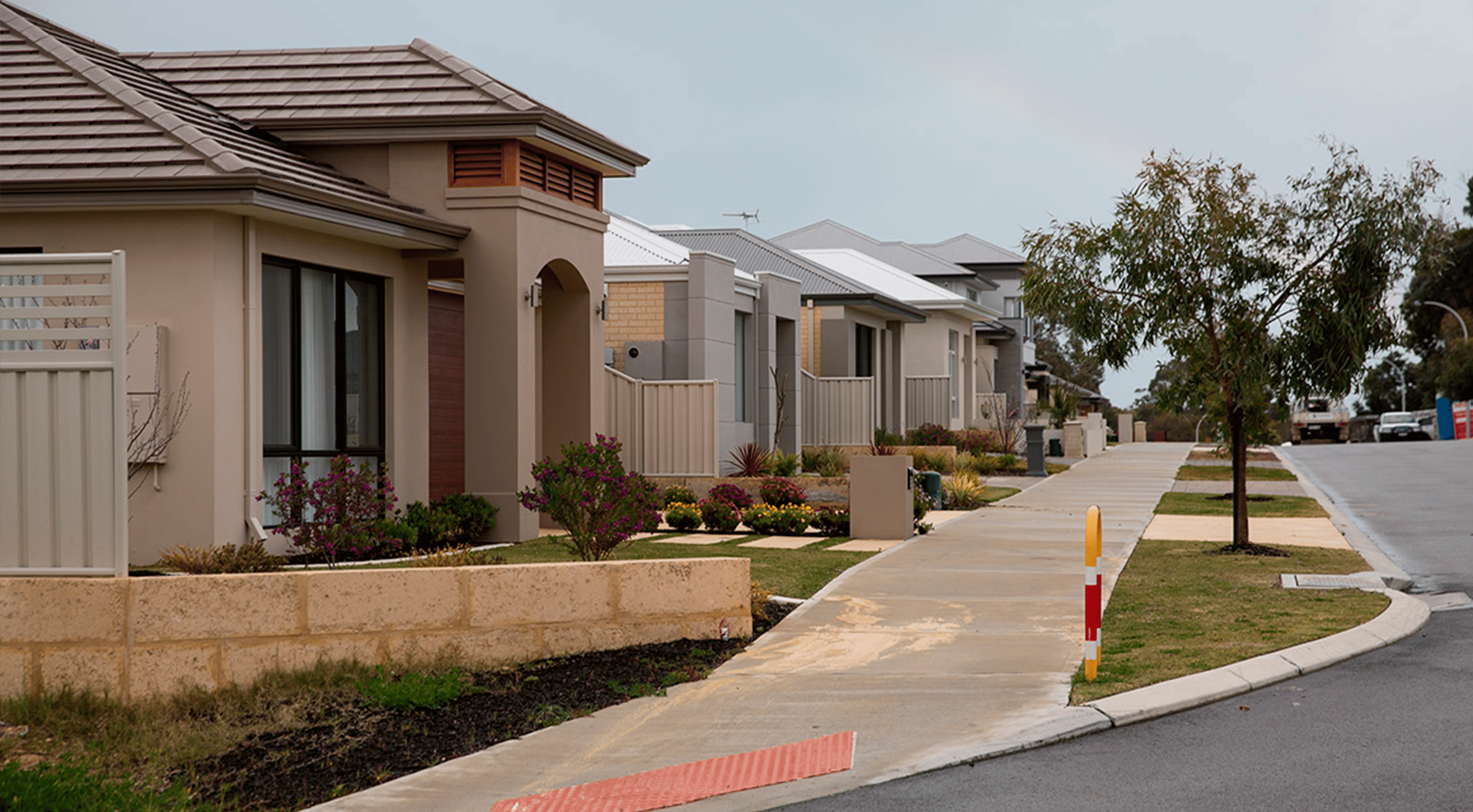Features > Property News & Insights > Investment News
Investor lending grew five times faster than owner-occupiers

Image from Domain.com.au
KEY POINTS
- ABS figures show new loans to investors grew more than five times faster in June than lending to owner-occupiers
- Analysts say investor demand - which has risen 30% over the past year - is being driven by strong rents in an undersupplied rental market, leading to higher gross rental yields
- The strength of the national property market also means that the average owner-occupier loan size is rising by $154 every day to a new record of $636,597
New loan data has underlined the strength of the property market, showing that the average owner-occupier loan size is rising by $154 every day.
The figures have been extrapolated from the latest ABS Lending Indicators data, which shows both owner-occupier and investor loans rose in the month of June.
The details

The Australian Bureau of Statistics (ABS) says new loans to owner-occupiers rose 0.5% in June to $18.7 Billion, which is up 13.2% from a year ago.
Loans to investors rose more than five times as much, or 2.7%, to $11.02 Billion, which is a whopping 30.2% up on the same time last year.
“Helping to stoke investor demand is a very tight rental market and higher gross rental yields,” says Oxford Economics Australia’s Senior Economist, Maree Kilroy.
Ms Kilroy says the demand from investors for finance is having repercussions in the mortgage market, with the interest rate gap between owner-occupier and investor mortgage rates tightening, with banks competing for market share.
Maree Kilroy points to Queensland as being a favoured investment destination.
“For the past four months, Queensland has been on par with Victoria in terms of investor demand,” she says.
“Queensland has increased 34.5% over the past year whilst policy tweaks towards investors in Victoria has contributed to a more muted 9.4% increase.”
Mortgage size

According to mortgage comparison website RateCity, the ABS data shows the average new owner-occupier mortgage in Australia is now $636,597—a new record high that it says “is set to keep on rising alongside property prices in key states.”
CoreLogic says national dwelling values have risen 7.6% over the past year to reach a median of $798,207 and that strong value growth means bigger mortgages are required to purchase real estate.
“Across the country, the average new owner-occupier mortgage has risen by $154 a day over the last 12 months,” says RateCity’s Research Director, Sally Tindall.
“On a 30-year mortgage, you can basically double that figure when adding in interest costs,” she says.
“In Western Australia, the average new mortgage for an owner-occupier is now almost $100,000 more than it was just 12 months ago—rising by a gobsmacking $257 a day.”
“It’s incredible to think this has unfolded under the weight of a rising cash rate.”
The RBA has held the cash rate steady at 4.35% since November last year—the highest level in more than 12 years—as it attempts to tame an inflation breakout.
“While there is seemingly no shortage of buyers prepared to up their bids at heated auctions in key capital cities, many would-be first-home buyers have their hands tied by the double whammy of rising rates and property prices,” Sally Tindall says.
She points to the number of owner-occupier mortgages written for first-home buyers being largely static at just 9,947 in June.
“This figure has managed to lift above the 10,000 mark just once since the start of the rate hikes—a far cry from the most recent peak in first-home buyer numbers recorded back in January 2021 when over 17,000 first-home buyer mortgages were written for owner-occupiers,” she says.
Signs of a home building recovery?
One of the factors that has kept home prices and rents rising, even in the face of persistently high interest rates, is a lack of supply.
Recent figures from the ABS showed building approvals fell to their lowest level in a financial year since 2011-12, with just 163,000 new dwellings approved in 2023-24.
“The number of loans issued for the purchase and construction of a new home has been steadily increasing since the start of 2024,” says Housing Industry Association Economist Maurice Tapang, although he admits that’s from “a very low base.”
“Market confidence appears to be stabilising following nine months without a change in interest rates.”
“The number of loans issued for the purchase or construction of a new home increased by 9.2% in the June quarter 2024 compared to the previous quarter.”
Oxford Economics’ Maree Kilroy says that loans for the construction of new dwellings increased 2.9% in June the latest ABS Lending figures, which she says is an important “lead indicator for the detached housing market.”
“Up 14.2% on a year ago, this is another sign we are past the worst for the new house market,” she says.
Although the home building industry may be “past the worst”, there is no question that it’s going to be an almost impossible task to reach the required average of 240,000 over the next five years to reach the ambitious national housing target of 1.2 million well-located and affordable new homes.
It’s this fundamental imbalance between housing supply and demand, particularly in the booming states of Western Australia, South Australia and Queensland, that’s going to keep home prices strong.
And for would-be buyers who put off buying a property, there’s the added problem of having to add at least $154 to their loan size for every day they delay stepping onto the property ladder.
Stay Up to Date
with the Latest Australian Property News, Insights & Education.




.png?width=292&height=292&name=Copy%20Link%20(1).png)
 SIGN UP FOR FREE NEWSLETTER
SIGN UP FOR FREE NEWSLETTER
%20(1).png)

.png)




.jpg?width=1920&height=1080&name=Warning%2c%20You%20Might%20Be%20Facing%20Higher%20Taxes%20Soon%20(1).jpg)





.png?width=1920&height=1080&name=Rate%20Drops%20Signal%20BIGGEST%20Property%20Boom%20in%20DECADES%20(1).png)

.jpg?width=1920&height=1080&name=Labor%20vs%20Liberal%20These%20Housing%20Policies%20Could%20Change%20the%20Property%20Market%20Forever%20(1).jpg)
.jpg?width=1920&height=1080&name=QLD%20Slashes%20Stamp%20Duty%20Big%20News%20for%20Investors%20%26%20Home%20Buyers%20(1).jpg)
.jpg?width=1920&height=1080&name=Trump%20Just%20Slapped%20Tariffs%20%E2%80%93%20Here%E2%80%99s%20What%20It%20Means%20for%20Australia%20(1).jpg)
.jpg?width=1920&height=1080&name=Federal%20Budget%202025%20More%20Debt%2c%20No%20Housing%20%E2%80%93%20Here%E2%80%99s%20What%20You%20Need%20to%20Know%20(1).jpg)
.jpg?width=1920&height=1080&name=Australias%20Housing%20Crisis%20is%20about%20to%20get%20MUCH%20Worse%20(New%20Data%20Warns).jpg)
%20(1).jpg?width=1920&height=1080&name=Australias%20RENTAL%20CRISIS%20Hits%20ROCK%20BOTTOM!%20(2025%20Update)%20(1).jpg)
%20(1).png?width=1920&height=1080&name=Is%20Adelaide%20Still%20a%20Good%20Property%20Investment%20(2025%20UPDATE)%20(1).png)
.jpg?width=1920&height=1080&name=RBA%20Shocks%20with%20Rate%20Cuts!%20What%E2%80%99s%20Next%20for%20Property%20Investors%20(1).jpg)
%20(1).jpg?width=1920&height=1080&name=I%20Predict%20The%20Feb%20Rate%20Cut%20(My%20Price%20Growth%20Prediction)%20(1).jpg)
.png?width=1920&height=1080&name=Why%20Property%20Prices%20Will%20Rise%20in%202025%20Market%20Predictions%20(1).png)
.jpg?width=1920&height=1080&name=Why%20Investors%20Are%20Choosing%20Apartments%20Over%20Houses%202%20(1).jpg)
.jpg?width=1920&height=1080&name=Why%20Rate%20Cuts%20Will%20Trigger%20A%20Property%20Boom%20(1).jpg)
.jpg?width=1920&height=1080&name=Retire%20On%202Million%20With%20One%20Property%20(Using%20SMSF).jpg)
.jpg?width=1920&height=1080&name=4%20Reasons%20Why%20You%20Should%20Invest%20in%20Melbourne%20Now%20(1).jpg)
%20(1).jpg?width=1920&height=1080&name=Old%20Property%20vs%20New%20Property%20(Facts%20and%20Figures%20Revealed)%20(1).jpg)
%20(1).jpg?width=1920&height=1080&name=Will%20The%20New%20QLD%20Govt%20Create%20a%20Property%20Boom%20or%20Bust%20(My%20Prediction)%20(1).jpg)
%20Scott%20Kuru%20(1).jpg?width=1920&height=1080&name=Inflation%20Hits%20Three-Year%20Low%20(Will%20RBA%20Cut%20Rates%20Soon)%20Scott%20Kuru%20(1).jpg)
.jpg?width=1920&height=1080&name=How%20to%20Buy%20Investment%20Property%20Through%20SMSF_%20The%20Ultimate%20Guide%20(1).jpg)
.jpg?width=1920&height=1080&name=Victoria%20Slashes%20Stamp%20Duty%20Melbourne%20Set%20to%20Boom%20Scott%20Kuru%20(1).jpg)
.png?width=1571&height=861&name=Are%20Foreign%20Buyers%20Really%20Driving%20Up%20Australian%20Property%20Prices%20(1).png)
.jpg?width=1920&height=1080&name=The%20Single%20Factor%20That%20Predicts%20Property%20Growth%20Regions%20(1).jpg)
%20Scott%20Kuru%20(1).jpg?width=1920&height=1080&name=My%20Prediction%20On%20Rates%20%26%20Negative%20Gearing%20(Market%20Crash)%20Scott%20Kuru%20(1).jpg)

-1.png?width=1920&height=1080&name=Major%20Banks%20Cut%20Rates%20Will%20RBA%20Follow%20Suit%20(Sept%20Rate%20Update)-1.png)
%20Scott%20Kuru-1.png?width=1920&height=1080&name=Rate%20Cut%20Coming%20What%20New%20Zealands%20Move%20Means%20for%20Australia%20(Sept%20Prediction)%20Scott%20Kuru-1.png)
%20(1).jpg?width=1920&height=1080&name=Buy%20when%20the%20interest%20rates%20are%20high!%20(Why%20you%20must%20buy%20now!)%20(1).jpg)
.jpg?width=1920&height=1080&name=Carms_Revised%20Taxes%20Due%20Aug%209%20YT%20Thumbnail02%20(1).jpg)
.jpg?width=1920&height=1080&name=Carms_Too%20Little%20Too%20Late%20Aug%207%20YT%20Thumbnail01%20(1).jpg)









.jpg?width=1920&height=1080&name=Carms_Rate%20Drop%20In%20July%20Jun%2010%20YT%20Thumbnail02%20(1).jpg)
.jpg?width=1920&height=1080&name=Carms_Own%20a%20Property%20V6%20Jun%205_YT%20Thumbnail%20(1).jpg)









.png?width=1920&height=1080&name=Artboard%201%20(3).png)






.jpg?width=1920&height=1080&name=YT%20thumbnail%20%20(1).jpg)

